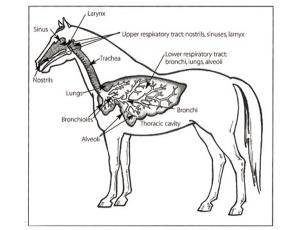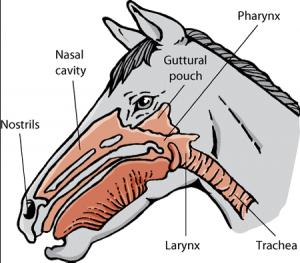On a very rainy Monday night, February 11, 2019, about 45 people braved the inclement weather to attend a seminar by Dr. Jennifer Dunlap on equine respiratory diseases at the Eads Civic Center in Eads, Tenn. Dr. Dunlap covered the most common infectious respiratory diseases in horses, what causes them, how to treat them, and, most importantly, how to help prevent them. Dinner of pizza and salad and drinks were provided, along with a variety of homemade desserts.
Dr. Dunlap first described how the horse’s respiratory system works and how the horse breathes. The horse’s respiratory system has two main parts: the upper airway and the lower airway. The upper airway is comprised of the nostrils and nasal passages, sinuses, larynx, and trachea. Horses are never mouth breathers – unless ill and can’t get enough air. The lower airway is the lungs – which have enormous capacity! At a gallop, horses breathe in approximately two five-gallon buckets of air per second, taking one breath per stride! At rest, the average respiratory rate for horses is 12-16 breaths per minute for adult horses; 30-40 breaths per minute for foals. It is good to have a baseline number for your own horse.
How to tell where the respiratory problem is located: If the horse has increased difficulty (or noise) breathing in, then it is most likely an upper airway obstruction. If the horse has to use increased abdominal effort to breathe out (or wheezes), it is almost always a problem in the lungs.
There are some ways that people can negatively impact the horse’s respiratory tract, and the first is how we house horses. She emphasized the importance of adequate ventilation in barns and the adverse effects of ammonia in barns. Proper ventilation removes stale air and brings in fresh air and helps horses thermoregulate.
Ammonia
Ammonia build up from urine is corrosive and burns the delicate tissue of the respiratory tract. It is also very damaging to foals that spend a lot of time lying down. There is an “ammonia meter” that can measure the amount of ammonia in a barn. But if you can smell it and your barn is closed tight, it’s time to re-evaluate how you house your horses. Make sure your bedding is absorbent and then remove, not just the manure, but also the wet spots. Consider using an ammonia neutralizer like PDZ in the stalls. And open the windows and doors to allow for cross-ventilation, but not a draft.
Another way is by feeding poor quality hay that is moldy and/or very dusty. Dust and mold are allergens, which can lead to chronic airway inflammation. Dr. Dunlap recommends buying “the best hay you can afford” and consider using haynets for allergy prone horses.
A third way is by not having a proper vaccination schedule. If you horse ever comes into contact with other horses, if you have broodmares and/or foals, if you travel with your horses, or other horses come into the boarding barn, a proper vaccination schedule is imperative! Rhino is the number one cause of early abortion, so definitely vaccinate your broodmares. She recommends requiring a negative Coggins test, vaccination record, and a health certificate or EECVI. So if any new horses come to your barn, they should show the required paperwork.
Next, she covered the primary infectious diseases to which horses are susceptible: Influenza, Rhinopneumonitis, and Strangles. She explained how they are contracted, the nursing care and medications for treatment, and, most importantly, how to prevent these diseases in your horse. Respiratory disease is second only to lameness as a cause of poor performance in horses.
Viral respiratory infections include Influenza (EIV); Rhinopneumonitis (equine herpes virus) of which the two major types are EHV-1 – respiratory, abortion, and neuro rhino and EHV-4, respiratory only. These diseases are characterized by high fevers, snotty noses, depression, off feed, and can be complicated by secondary bacterial pneumonia.
For Influenza (EIV) Type A virus (A/equine 2), the Equine Rhinopneumonitis-Influenza vaccine is very effective. Horses with Influenza can have very high fevers (105+) and a secondary risk is laminitis. For horses with Influenza, quarantine and good nursing care are a must!
Viral respiratory diseases are diagnosed with a deep nasal swab for PCR testing, results of which are obtained in 24-36 hours. They can be accompanied by a secondary bacterial infection, which is characterized by a thick yellow/green nasal drainage and a low grade fever that won’t go away. These horses whould be separated from other horses by at least 30 feet. Nursing care can include Banamine to bring down their fever, ice their feed, and keep out of inclement weather.
Neuro Rhino-Equine Herpes or Myeloencephalopathy (EHV-1 subtype) can come on suddenly, spread quickly through a barn, and can be fatal in its most aggressive form. This disease damages the blood vessels of the blood-brain barrier. Signs include nasal drainage, uncoordination, loss of tail tone, lethargy, urine dribbling, head tilt, leaning against a wall to stand, or the horse is down and unable to stand. Treatment includes IV fluids, supportive care, and may include the antiviral drug Valacyclovir. Even though the Rhino vaccine is not licensed for the neuro form, Dr. Dunlap has seen it offer some protection.
Strangles is caused by bacteria that spreads with the speed of a virus. Horses with strangles have high fever, enlargement of the lymph nodes around the throat, and it is very contagious! Quarantine of these sick horses is a must! Dr. Dunlap was somewhat ambivalent about the effectiveness of the vaccine.
Purpura hemorrahagica is an autoimmune response to strep bacteria. Horses exhibit limb swelling, skin sloughing, and internal hemorrhage. This is a problem that must be treated quickly and aggressively.
The final way that humans can spread equine respiratory disease is by being/having a fomite (new word added to folks’ vocabularies). A fomite is any nonliving object or substance capable of carrying infectious organisms, such as viruses or bacteria, and hence transferring them from one individual to another. Examples include a person not changing their clothes or boots between sick and healthy horses; not disinfecting a horse trailer between horses; using contaminated water hoses, feed buckets, muck buckets, and wheelbarrows. Dr. Dunlap gave emphatic coverage to quarantine protocols to make sure respiratory infections do not spread. A good rule of thumb is to keep a sick horse isolated at least 30 feet from other horses and have appropriate personal protective equipment. Quarantine sick horses and allow only necessary personnel in this area that are gowned, gloved, and in booties. Ideally, people treating sick horses should not handle healthy horses.
One other comment about disinfectant: bleach is NOT the best choice! Undiluted bleach emits a toxic gas when exposed to sunlight; it degrades quickly; is irritating to mucus membranes and skin; takes 10 minutes to an hour contact time; and if often mixed in improper concentrations. What works best? “Rescue” disinfectant, which can be used in footbaths, washing and wiping surfaces, and disinfecting even fragile equipment. Rescue concentrate, mixed at 1:16 dilution, is an effective bactericidal/ fungicidal/virucidal agent, taking only 5 minutes to work. The product also comes in wipes and ready to use formula.
The final topic she covered is the new EECVI (Extended Equine Certificates of Veterinary Inspection), which replaces the old paper six-month passport/health certificates. These digital passports are handy for clients who travel to multiple states.
Editor’s Notes: Other publications have written about the hazards of ammonia to your horses. Tractor Supply Co. published “How Ammonia Can Damage Your Horse’s Respiratory System.” https://www.tractorsupply.com/know-how_pets-livestock_horse_how-ammonia-can-damage-your-horses-respiratory-system
The Horse.com has published a couple: “Ammonia is the Enemy.” https://thehorse.com/129872/ammonia-is-the-enemy/ and “Ammonia: A Hidden Danger in the Barn.” https://thehorse.com/18722/ammonia-a-hidden-danger-in-the-barn/ They also published a white paper: “Ammonia & Respiratory Health.” https://thehorse.com/wp-content/uploads/2018/04/ammonia-and-respiratory-health-30023-FS.pdf
This scientific study examined the effect of two bedding materials in stalls and how they affect stable air quality, specifically ammonia and dust levels, and the respiratory health of horses. https://www.ncbi.nlm.nih.gov/pmc/articles/PMC4693198/
Additional resources on equine respiratory diseases:
Merck Vet resource: https://www.merckvetmanual.com/respiratory-system/respiratory-diseases-of-horses/overview-of-respiratory-diseases-of-horses
AAEP resource: https://aaep.org/horsehealth/respiratory-problems
Find information on Rescue at: https://rescuedisinfectants.com/










